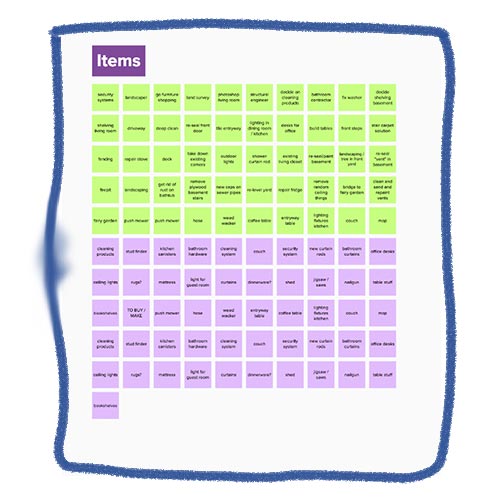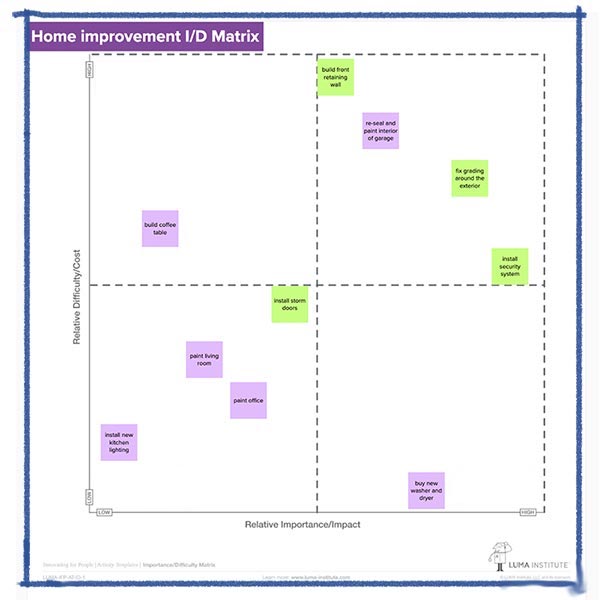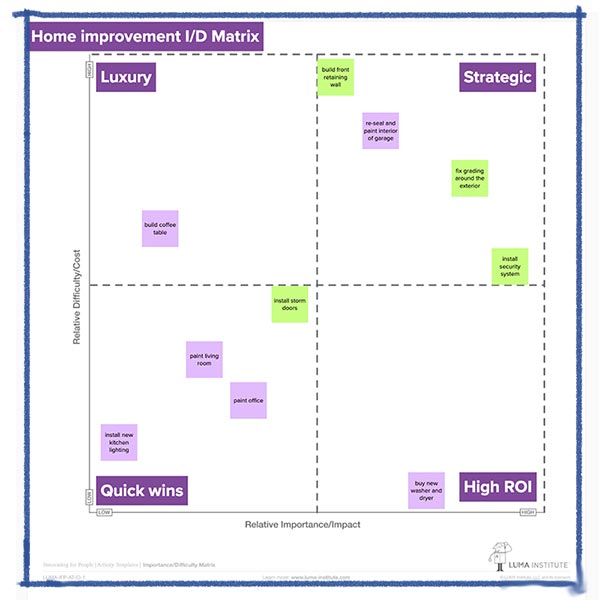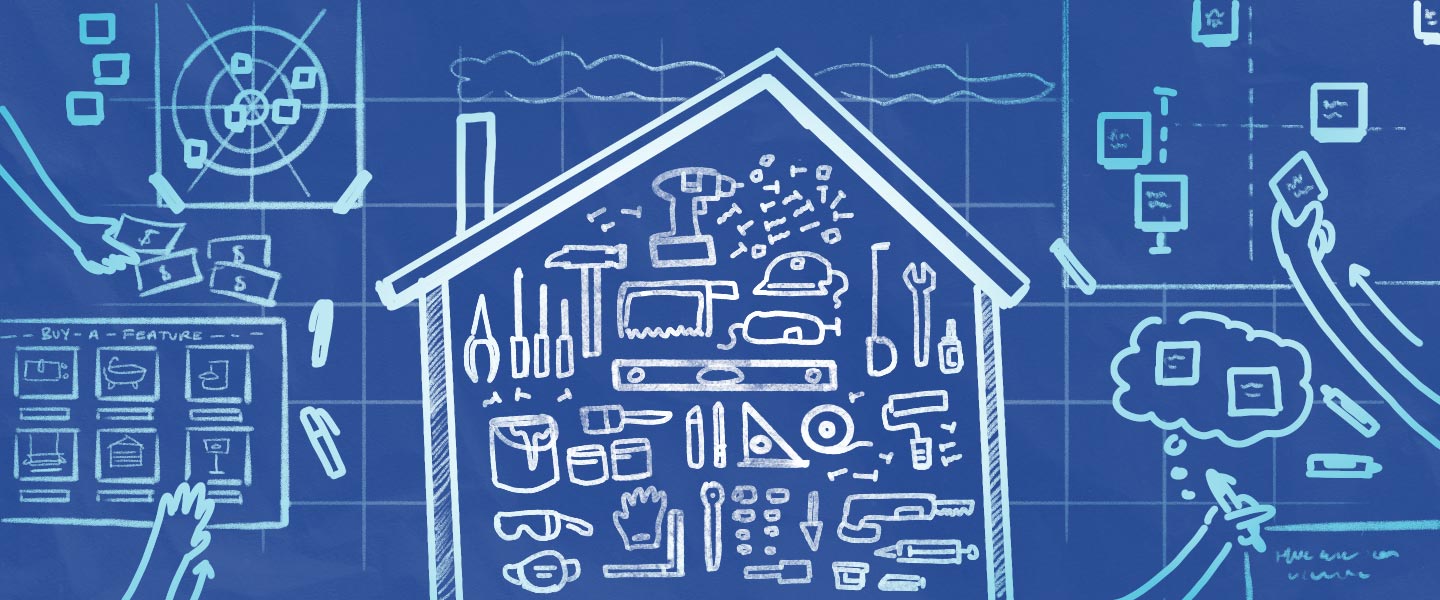So, my partner and I had successfully navigated one of the toughest housing markets in years. We’d interviewed realtors, researched neighborhoods, applied for a mortgage, found our dream starter home, and made it through the inspection with minimal stress.
We were relieved and elated, and we were eager to start this new chapter. And then the list of home improvement ideas began to pile up. Schedule an electrician; shop for a washer and dryer; paint the living room; build a three-foot retaining wall; buy a weed wacker; have a fence installed for the dog. Just to name a few, of course.
Our list of tasks was overwhelming. And each item completely differed from the next in terms of complexity, investment, difficulty, time commitment, and importance. Of course we knew home ownership would be no small undertaking, but we were humbled when we saw our Excel spreadsheet of project ideas get longer… and longer…
We needed a simple way to decide which tasks to tackle and in what order. So we turned to one of my favorite human-centered design methods from the LUMA System: Importance/Difficulty Matrix. You simply plot items on a 2×2 matrix according to their relative importance (x-axis) and difficulty (y-axis). Seeing each item arranged in this fashion, versus a simple list, helps you work out the tension between those two opposing forces and leads to better prioritization and decision-making.
Step one: identify your ideas
We began by taking that monster of an Excel spreadsheet and pasting each item as its own sticky note within MURAL, a digital whiteboard. But of course you could use paper sticky notes! We color-coded the sticky notes according to whether they were an inside or outside project, but that’s optional.

First, we needed to narrow down our list to a more manageable set. Importance/Difficulty Matrix works great with 10-12 items, but our original list included dozens. So we quickly employed another method: Visualize the Vote. We set a timer for five minutes, and my partner and I used sticky notes to each vote on the 10 items we wanted to prioritize.
After we voted, we discussed why we chose our top 10, and luckily, we were already aligned on six out of 10 projects! But we were split on the remaining four. So we set another five-minute timer and negotiated about the other four items to include. It’s often a good idea to timebox these kinds of discussions to force a decision and avoid overthinking. After all, this was going to be the first of many matrices we would complete throughout our project planning – we’d have plenty of time to discuss ideas again later!
After reaching alignment on our 10 items, we started to plot them on our matrix.
Step two: Consider importance
Importance or impact comes first. My team at LUMA likes to start this exercise by placing one item in the middle and then adding more, one by one, judging them against those we already plotted. For example, we placed “re-seal and paint the interior of the garage” in the middle. We then pitted it against “fix grading around the exterior” and discussed which item was more important.
Here’s a good reminder: Just because you’re ranking something as lower importance doesn’t mean that it’s un-important in the grand scheme of things – it’s just less important relative to the other ideas on the matrix.
Don’t be afraid to move the sticky notes around multiple times to get the order right, and once you’re done ranking everything, read through it once more. Question your choices: “Is this really more important than that?”
Step three: Examine difficulty
Now it’s time to rank according to difficulty or cost: you’ll move the items up or down, ranking them against each other. At this point, don’t move anything horizontally; you’re only thinking about difficulty!

Since we’re talking about home improvement projects, it might be good to keep cost in mind while you rank vertically. Your interpretation of how difficult or costly a project could be will be influenced by multiple factors: will the project involve a lot of stakeholders such as contractors, family members, or pets? How much budgeting will you need to do? If you enjoy do-it-yourself projects, do you feel confident managing the project or do you need to do more research?
Here’s an example of how these considerations could change a matrix: we included “buy a new washer and dryer” on our list. We ranked it as very high-importance because we need clean clothes. When we considered difficulty as a sorting mechanism, we envisioned that project very low on the matrix because it really just entails researching what products we want to buy and scheduling them to be delivered. But when we considered cost, we agreed it was one of the more expensive projects we were pursuing.
Ultimately, we placed it lower on this axis because it made more sense for our project list and budgeting.
Keep in mind as you rank items: No two ideas should be in the same position on either axis since you need to decide which items are truly the most or least important and difficult.
Step four: Assess your matrix
Now take a look at your final product. You’ll see some clear themes emerge given the quadrant an item landed in.
Items in the upper left quadrant are Luxuries; items in the upper right quadrant are Strategic; items in the lower left quadrant are Quick Wins; and items in the lower right quadrant offer High Return on Investment.

From here, you have a few options to further prioritize your matrix.
You could simply work your way through the tasks in each quadrant based on their relative importance and difficulty: we began by accomplishing everything in the Quick Win and High ROI quadrants and then working our way toward the Strategic and Luxury projects.
You could also label the items according to similarities i.e. projects that would take a lot of manual labor vs more relaxed projects; or projects you already own the tools to complete versus projects that will require a trip to the home improvement store; etc.
Tackling the to-do list
Conducting this exercise didn’t change the fact that we had an extensive to-do list, but it absolutely re-shaped the way we viewed it. This method forced us to trim down our short-term goals significantly and gave us a place to start and tangible next steps.
The LUMA System includes several methods to help you prioritize to-do lists or plan home improvement projects. For example, my colleague Dustin quickly covered how you might use What’s on Your Radar to accomplish a similar goal in a previous blog post. You could also employ Buy a Feature to budget for your home improvement ideas or create a Concept Poster to envision a redesign of a room or dwelling space.
The beauty of all these methods is that they’re versatile and simple: you don’t need to be an expert-level design thinker to harness their power. So next time you take a look around your home and feel overwhelmed by all that you want to accomplish, grab some sticky notes and get going!

